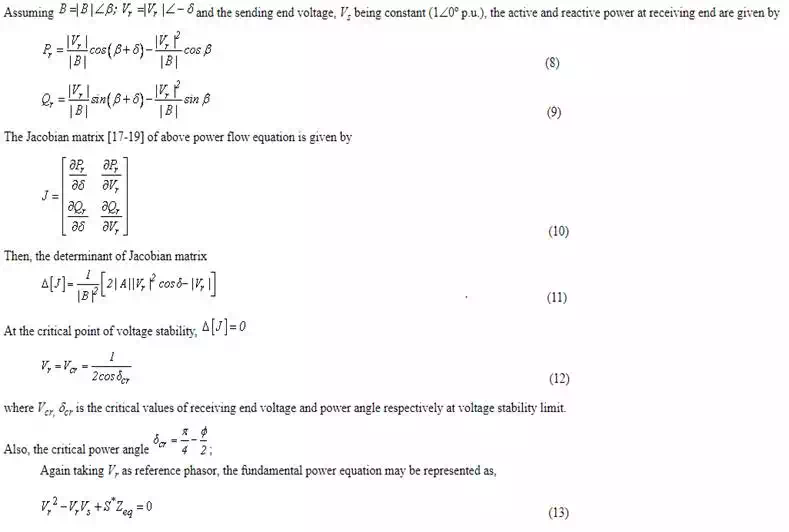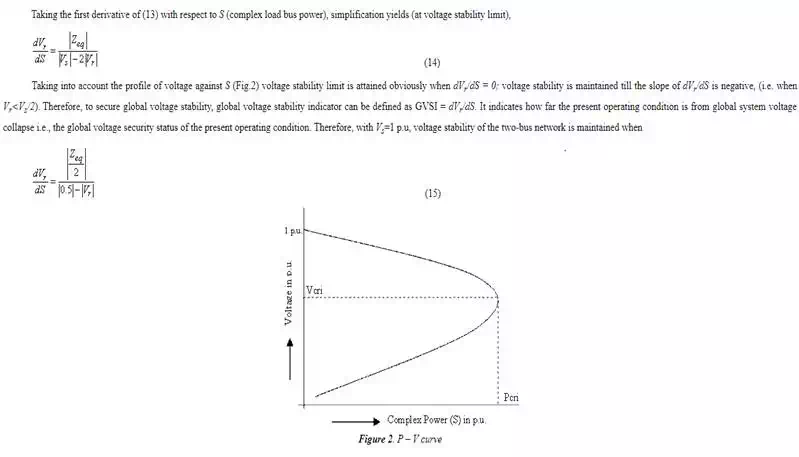Voltage Stability Analysis
Abstract
This paper presents a methodology for assessing the voltage stability using the concept of equivalencing the multi-bus power system to a two-bus network model and by studying the necessary parameters of the equivalent system. There by, a generalized global voltage stability indicator being developed, it has been applied to a robust practical 203-bus Indian Eastern Grid system. Simulation results indicate that this optimal power flow (OPF) based network equivalent approach is promising to assess voltage stability of any power system at any operating point in global scenario. In addition, the application of thyristor controlled series capacitor (TCSC) compensator at critical line indicates the improvement of global voltage stability at all operating conditions. In the equivalent network the generators are modeled more accurately considering economic criteria.
Introduction
To meet ever-increasing electrical load demand, the modern power systems are under going numerous changes and becoming more complex from operation, control and stability maintenance standpoints. The major problem that associated with such a stressed system is voltage instability or collapse. A system is said to enter a state of voltage instability when a disturbance causes a progressive and uncontrollable decline in voltage, which can occur because of the inability of the network to meet the increased demand for reactive power. Many recent power system blackouts all over the world have been the consequences of instabilities characterized by sudden voltage collapse phenomena [1, 2]. Therefore, the voltage stability analysis is essential in order to identify the critical buses in a power system i.e., buses which are closed to their voltage stability limits and thus enable certain measures to be taken by the operators in order to avoid any incidence of voltage collapse.
Many analysis methods [3-6] of voltage stability determination have been developed based on the load flow solution feasibility, optimal power flow, bifurcation technique, singularity of Jacobian etc. Different voltage stability indicators have also been established covering both static and dynamic aspects of the problem [7]. Efforts also have been made to assess the voltage stability of large power systems in terms of network equivalents to obtain the global picture of voltage stability. The power system equivalents are of importance [8-10] for the study of static characteristics of a large system when either the computer facilities for direct solution or the available solution time is restricted. The use of equivalent representation of the complex system simplifies the lengthy calculations and analysis system stability easily. This paper describes a unique method of equivalencing a multi-bus power network to an equivalent two-bus system developed from optimal power flow solution and thereby voltage stable states of the entire system following the load changes in ‘weak’ load buses investigated for a typical power system networks. The simulation also includes the detection of the ‘weak’ load bus/buses and identification of the global voltage stable states of the system following the derived two-bus equivalent system simulation [11-13].
Next, this paper concentrates on the application of Flexible AC transmission system (FACTS) to enhance the power system performance in terms of voltage stability. With the development of FACTS controllers, there is a growing interest in using these devices to provide voltage and power flow control in power systems. Their application in improving the overall performance of the power system is discussed in [14]. FACTS controllers have been defined by IEEE as ‘alternating current transmission system incorporating power electronic based and other static controllers to enhance controllability and increase power transfer capability’ [15]. Among the existing FACTS devices, the thyristor controlled series capacitor (TCSC) compensator has been effectively used to increase the line power transfer as well as to enhance the voltage stability of the system. Hence, in this paper an attempt is made to study the role of TCSC compensator installed at critical lines and its effect on local as well as global voltage stability [16], following the computer simulation. Voltage stability enrichment with the application of TCSC is compared with the results obtained for normal system.
Optimal Power Flow
The main purpose of an OPF program is to determine the optimal operation state of the power system by optimizing a particular objective while satisfying certain specified physical and operational constraints. In this paper, Newton’s method of optimal power flow has been utilized to assess the voltage stability of the multi-bus power system considering economic criteria.


Development of Equivalent Two-Bus Network
Let us assume a two-bus equivalent network where sending end bus is assumed as a generator bus and receiving end as a load bus connected by a line impedance, representing the equivalent of the entire multi-bus network as shown in Fig.1.

The behavior of the proposed two-bus equivalent network will be same as that of multi-bus network and it should reflect the common properties of the original system [17, 18]. Therefore, the power balance equation for the two-bus equivalent network can be written as
![]() (5)
(5)
The complex power loss for this equivalent system is given by


